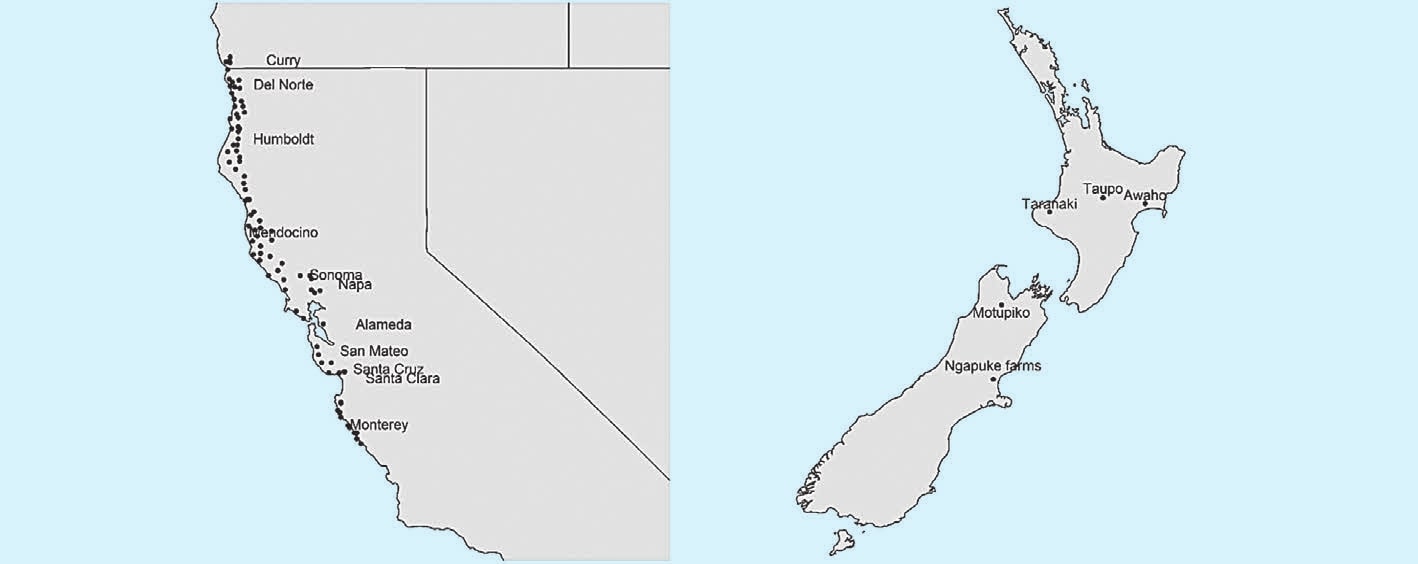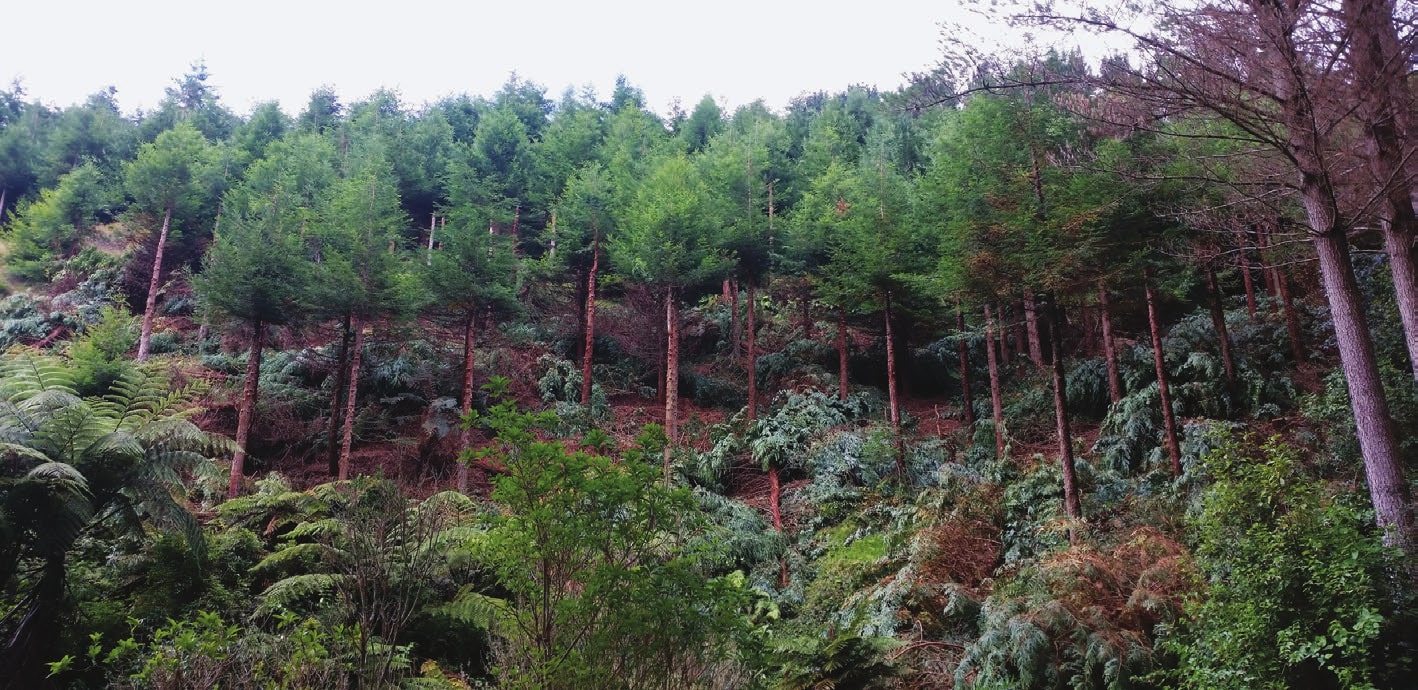Redwood stability across the environment
Paul Silcock and Simon Rapley, New Zealand Tree Grower August 2017.
An emerging opportunity
The Sequoia Action Group successfully applied to the Sustainable Farming Fund in July 2015 looking to build on redwood genotype x environment research undertaken by Future Forests Research in 2013. The previous project was limited in scope to analysing data only from two high productivity sites of the 11 Kuser trials in New Zealand. The 2016 work included three additional sites and the results indicated that −
- The best clones at one site would probably remain the best clones at another
- There was medium-to-high genetic control for all growth and wood property traits measured, while epicormic shoots were under low genetic control
- On average, rapid redwood growth will probably result in lower wood density.
With co-funding from The New Zealand Redwood Company, SAG and NZ Forestry Ltd, Scion were contracted to carry out an extension of the analysis, looking at the growth performance and wood quality traits of the 198 Kuser clones from 90 locations at five New Zealand trial sites. The project began in June 2016. Representatives from the funding organisations considered that one of the most important issues for people wanting to grow redwood in New Zealand is genetics and quality of planting stock. Understanding how site influences redwood productivity is important as redwood is sensitive to temperature, wind, soil moisture, soil fertility and mycorrhizal associations.
It is well established that we can grow and manage redwood stands successfully. However, there is no formal breeding programme. Instead, independent programmes by growers who are making selections among clones from various importations and from domestic material. The objective of this study is to provide information to growers on how the performance of clones changes across sites and where, from the natural range of redwoods, do the best trees for New Zealand come from?
What we found out
The sites at Awaho, south of Wairoa, and Taranaki represent higher quality forestry sites, ideal for growing redwood with high annual rainfall spread evenly across the year and with deep fertile soils. The two sites in the South Island at Motupiko and Ngapuke represent lower quality sites with limited rainfall, higher mean wind speed and a shallow soil profile The Lake Taupo site with free draining ash soils and high altitude was so unsuitable for redwood that it was removed from the analysis.

Diameter at breast height, the presence of epicormic shoots, wood density and stem acceptance were measured. These traits were investigated for presence of genotype x environment interaction by using mixed statistical models.
Clonal rankings were consistent across high quality sites. Where site quality was poorer, these rankings were not consistent, meaning some clones were more sensitive to changes in site conditions than others. This is helpful to growers as it gives confidence that a clone selected for superior growth and wood properties from a good site will perform in a similar manner on another good quality site somewhere else in New Zealand.
If there is one or more provenance of coast redwood which is better suited to New Zealand conditions, it did not become obvious during this study. In addition, there was no relationship between the genotype’s performance in New Zealand and the climate or geographic location of the its origin.
Implications for redwood growers
We can assume that genotypes from any part of redwood’s natural range may do well in New Zealand, so seed collected from any part of the natural range will include some genotypes well suited to New Zealand. There is already evidence of this here. We do not have any reason to favour any part of the natural range over others. If a genotype has proved to be a good tree on a good site then we can also assume that it will be a good tree on another good site.
The best evidence of good performance of redwood here is from field trials in New Zealand. The climate of California is very harsh. Most growing seasons are dry without any rain for five or six months from mid-spring to mid-autumn. It would therefore be speculative to assume a genotype which performs well in California will also do well in New Zealand.
In the short term, redwood growers should ask for evidence of the performance of clonal stock on good sites in this country. Wood properties, stem form and tendency to grow epicormic shoots following pruning are important traits along with growth rate.
Redwood growers will get the best results by planting redwood on the best sites. There are tree crops that will do well on tough sites but coast redwood is not one of them. Consideration should be given, when establishing redwood on low quality sites, whether the investment into high quality genetic material is worth pursuing, or whether using lower cost seedling material is a more suitable strategy.
Wood properties
The study showed a clear negative relationship between diameter at breast height and wood density. What does this mean and should we be worried? Redwood is a low-density wood with a range of basic densities. These were identified in the Mangatu Sawing Study of 13 sample trees 38 years old sample trees, with a range from 274 kilograms a cubic metre to 420 kilograms a cubic metre.
Arguably the most important feature of redwood is its dimensional stability although durability is also very important. One of the reasons redwood is a very dimensionally stable wood is because of its low basic density. Walker, in 2006, explains that high density woods have proportionally more cell wall and less lumen − the space inside the cell − and so shrink and swell more.
We do not want to produce dense redwood as we do not want to use it as structural wood where strength is important or for paper production where high density equates to high yield. Redwood breeders and growers should be trying to produce wood of consistent properties, including density. Wood of either very low density or very high density is undesirable but there is a range of densities perfectly acceptable for the intended end use of New Zealand grown redwood.

The future
Redwood growers need to develop a breeding strategy to ensure the best genetic gains are available for the industry in the long term. While we did not identify a provenance effect, we know there are limitations in the sample size of the Kuser collection. It may therefore be possible to identify a group of provenances which are best suited to New Zealand from the natural range of redwood as the next best option. Selection of a range of provenances is actually quite normal in tree breeding programmes.
The Rotoehu provenance trial may also yield further information or selections which could improve our understanding of the redwood population. If we can identify better provenances then seed collections from superior trees within those provenances should be made for breeding in New Zealand.
A second alternative is to identify the best redwoods from across New Zealand that already appear to have good local adaptation and performance, and combine these with unrelated genotypes with known traits from cultivars already identified and field tested here. A third option is to run both options together, to take advantage of the widest and best genetic material that can be accessed, no matter what the source. What is clear is that we, the redwood growers of New Zealand, who now represent over 7,000 hectares of young forest, need a breeding strategy. We did not get all the answers we were hoping for from this study but we are fortunate to have access to some of the best minds in the business to help set a course for the future.
The Kuser study
The Kuser study is an abbreviation of International Range Wide Provenance Test of Sequoia sempervirens. Professor John Kuser from the Department of Horticulture and Forestry, Cook College, Rutgers University, New Brunswick, with assistance from Professor Bill Libby from the Department of Forestry, University of California and Jim Rydelius of Simpson Timber Company undertook a range wide study of coast redwood.
The purpose of the study was to study genotype by environment interaction of the species by sampling genotypes from throughout the natural range of redwood and establishing clonal replicate tests within the natural range and at overseas sites.
The method
Two randomly selected genotypes from 90 different locations throughout the natural range of redwood were sampled for the purpose of reproducing copies for use at trial sites. Trial plots were established in California, Oregon, Hawaii, Spain, France, New Zealand, Thailand, India, Chile, Britain, Ireland and south-eastern United States. The intention was to monitor differences in date of seasonal onset of growth, height growth, diameter growth, branch and crown measurements, wood density, age at first cone production, cone abundance, heartwood to sapwood ratio and stem taper.
The writers do not know how far this objective has been accomplished. It would appear that with the passing of Professor Kuser and changing trial site ownership, continuing measurement of trials has not been conducted or collated for analysis. Trial sites are known to exist in California and France but attempts to access data from these sites last year was not successful. The California site has suffered from bear damage and the French site has changed ownership and the new owners are not sure what to do with the trial.
Of course, most of our interest in New Zealand is how the various genotypes have performed in trials. Jim Rydelius, former General Manager of The New Zealand Redwood Company, imported almost a full set of Kuser clones to New Zealand. These clones were multiplied at nurseries and distributed to the Kuser trial sites.
The Sequoia Action Group consists of redwood growers and enthusiasts from New Zealand and the US. There has been a modest but focussed programme of innovative work on clonal breeding, silvicultural management and wood properties undertaken since the sequoia renaissance of early 2000. This group, with industry and research support, steers the existing research programme while pooling and disseminating the experience and knowledge of farm foresters growing sequoia. The committee consists of Paul Silcock, Russell Coker, Graham Milligan, Jeremy Thomson, Ian Brown, Robert Appleton and Dougal McIntosh.

 Farm Forestry New Zealand
Farm Forestry New Zealand